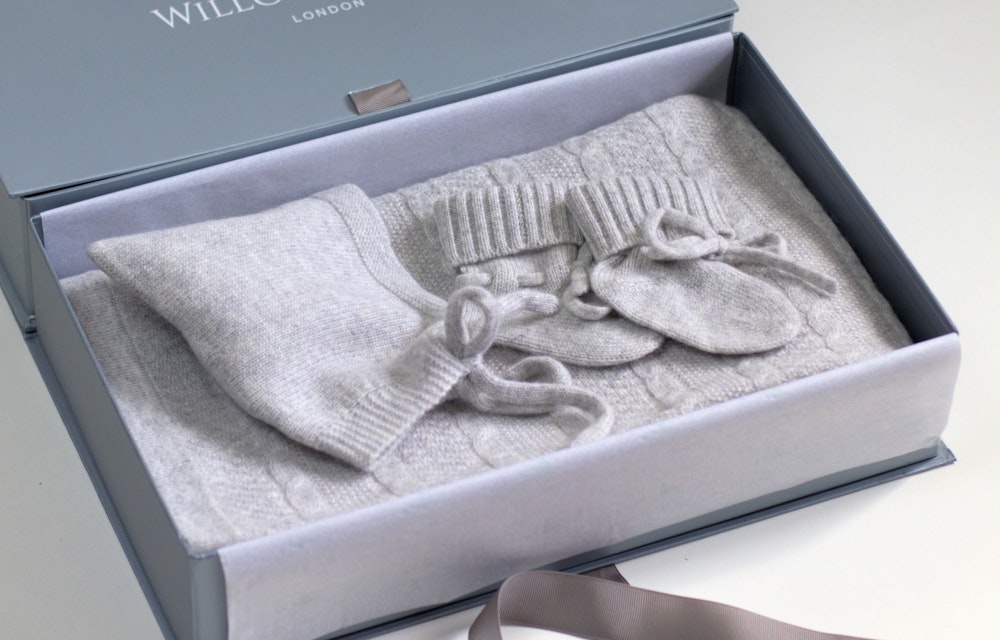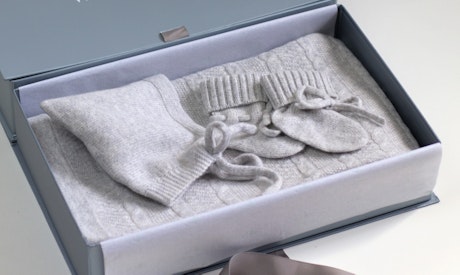

Cashmere Baby Blanket Care: Our complete guide on how to Wash, Dry & Maintain.
Bringing a cashmere baby blanket into your nursery is the long lasting luxury to add to everyday cuddles—warm, breathable and beautifully gentle. This guide walks you through exactly how to care for it: when to wash (and when not to), the safest hand-wash and machine-wash methods, drying and reshaping, stain removal for baby messes, de-pilling, storage, and troubleshooting—so your blanket stays heirloom-soft from first nap to forever.
Why cashmere baby blankets deserve gentle care
Cashmere is a natural protein fiber (from the soft undercoat of cashmere goats) prized for its warmth-to-weight ratio and exquistely soft feel. Those superfine fibers give your baby that breathable, temperature-regulating comfort. Cashmere however does require a little more care than cotton and therefore we recommend for cashmere to stay beautiful longest you avoid excessive heat, wash sparingly, and use a mild, wool-friendly detergent; cashmere can go months between full washes if it remains free from spills.
Ulitmately hand-washing with cool water, using gentle detergent, avoiding wringing/twisting, and drying flat are the golden rules that prevent stretching or felting.
Sustainability bonus: well-cared-for cashmere lasts for years, reducing replacement buying—better for your wallet and the planet.
When and how often to wash your cashmere baby blanket
Let practicality lead:
Daily or frequent use with minimal spills: Air the blanket between uses and spot clean marks where required.
Before first use for sensitive skin: A quick cool hand-wash with a baby-safe wool wash can be reassuring.
Preparing your blanket for washing
Check the care label
We recommend to follow the label first. If it says “hand wash only,” do not machine wash. For the safest results if unsure default to hand-wash this will provide the reassurance that you are not causing long term damage to the material.
Pre-treat stains
Dab (don’t rub) with cool water and a tiny drop of wool-safe, enzyme-free detergent or mild soap. Enzymes can attack protein fibers like cashmere.
For milk/formula/spit-up, loosen residue with cool water first, then treat gently.
Secure loose threads
Tuck any loops safely to prevent snagging.
Choose a mild detergent - Avoid Fabric Softener
Look for cashmere/silk/wool detergents (baby-safe, enzyme-free). Avoid fabric softener as these add an artificial coating which can cause long term damage to the cashmere fibres.
Water temperature -
Use cool to lukewarm water to avoid shrinkage. Temperatures from 10-20 degrees is ideal.
The 7 step-by-step Guide on Handwashing.
Hand-washing is the gentlest, most controllable method.
1) Fill and dilute (1–2 minutes)
Fill a clean basin with cool–lukewarm water. Dissolve a small amount of wool-safe detergent before the blanket goes in.
2) Submerge and soak (5–10 minutes)
Submerge the blanket and gently press it through the water. Avoid scrubbing or twisting and apply short stroke movements.
3) Gentle kneading (1–2 minutes)
For tougher stains lightly knead/press sections to encourage soil to release any ingrained dirt. Avoid rubbing fibres together.
4) Rinse (2–3 minutes)
Drain and refill with clean cool water. Rinse thoroughly until water runs clear. Keep handling minimal.
5) Remove excess water (1 minute)
Do not wring. Support the blanket and press against the basin side to expel any excess water.
6) Towel roll (1–2 minutes)
Lay the blanket flat on a towel, roll up like a swiss roll, and press further absorb more water.
7) Reshape & dry flat (see next section)
Transfer to a dry towel or drying rack, reshape to original dimensions and let it air-dry.
AVOID : Excessive heat, no tumble drying and avoid direct sunlight.
Drying & reshaping
Lay the blanket flat on a fresh towel or mesh rack in a well-ventilated area away from direct sunlight and heat. Reshape corners and edges while damp; pat gently to restore the knit. Dry flat and avoid heat or hanging.
If corners look a touch stretched:
-
Wet-block gently: mist with cool water, coax edges to shape, and dry flat.
-
For tiny laddered stitches, use a blunt needle and matching yarn to ladder/mattress-stitch back into place (micro-repairs only). For anything more than minor tweaks, a professional knitwear repair may be needed.
Stain removal tips (baby edition)
Cashmere is protein-based, so treating it kindly is a must.
Milk / formula :
Blot fresh spills with a clean cloth. Rinse the area with cool water, then dab with a drop of wool-safe, enzyme-free detergent. Rinse again and press dry with a towel. Avoid hot water and enzyme based detergents on your cashmere baby blanket.
General rule:
Patience beats rubbing. Rubbing can felt the fibers. Always finish by pressing water out therefore avoid any form of wringing.
De-pilling & general maintenance
Pilling (little bobbles) is normal in natural fibers and shows up where there’s friction (car seat straps, pram edges, favourite cuddling spots). This pilling doesn’t indicate poor quality; it simply needs periodic removal. Use a cashmere comb or a gentle fabric shaver and work in one direction, with light pressure.
We recommend Regular de-pilling to keep cashmere smooth and looking its very best.
Storage:
Fold, don’t hang (hanging stretches knit).
Store clean (moths prefer soiled fibers) in a breathable cotton bag or drawer.
Add cedar or herbal sachets as a moth deterrent
Troubleshooting common problems.
It shrank or felted.
Felting happens when heat, moisture and friction combine. Stop washing; soak in cool water with wool conditioner, then gently wet-block to size.
It feels less soft.
Residue build-up can make fibers feel “stiff.” Do a cool rinse or a short re-wash with a tiny amount of wool-safe detergent; rinse very thoroughly. As mentioned previously avoid softeners as they can damage fibers.
Persistent odour.
Air on a drying rack for 24–48 hours. If needed, re-wash gently and dry fully flat in an airy space.
Colour transfer onto the blanket.
Always hand wash with similar colours. If transfer occurs, professional cleaning may be safest option.
Quick-care checklist (print/save)
-
Air between uses; wash only when needed.
-
Spot-clean quickly with cool water + wool-safe, enzyme-free detergent.
-
Hand-wash in cool–lukewarm (10–20°C) water; never wring.
-
Dry flat; keep away from heat and sunlight and no tumble drying.
-
De-pill with a cashmere comb or gentle shaver as needed.
-
Fold and store clean with cedar sachets; avoid hanging as this stretches the fibres.
FAQ
Can I machine wash a cashmere baby blanket?
No. We generally recommend hand wash only. The hand wash cycle on washing machines may suffice in only some circumstances.
How often should I wash it?
Not as often as you think. If there are no spills or odours, you can go weeks or even months between full washes—just air and spot-clean.
How do I remove milk or formula stains?
Rinse with cool water, then dab with a wool-safe, enzyme-free detergent. Rinse again and press dry in a towel.
Will washing ruin the softness?
In short no—gentle washing actually refreshes fibers. Loss of softness usually means detergent residue or heat exposure. Rinse well, skip softener, and always dry flat away from heat.
What temperature water should I use?
Stay cool to cold. Cooler is always safer.
A worthy investment.
A cashmere baby blanket is more than a nursery extra—it’s the cosy companion for first naps, chilly pram walks, and quiet feeds. With gentle washing, patient drying, and a little de-pilling now and then, your blanket keeps its cloud-soft touch and elegant drape for many years to come.
Ready to top up your nursery or find the perfect gift? Explore our cashmere baby blankets, discover the Cashmere Knit Baby Blanket, or choose the Evie & Merino Cashmere Baby Blanket Set—thoughtfully boxed and ready to love.

